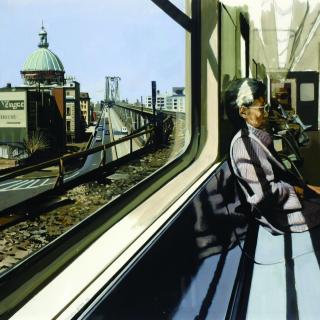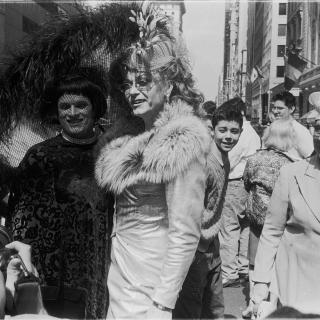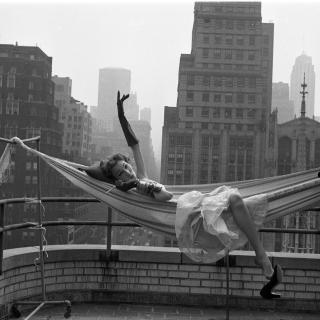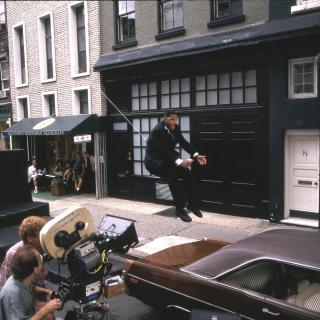At Home in New York
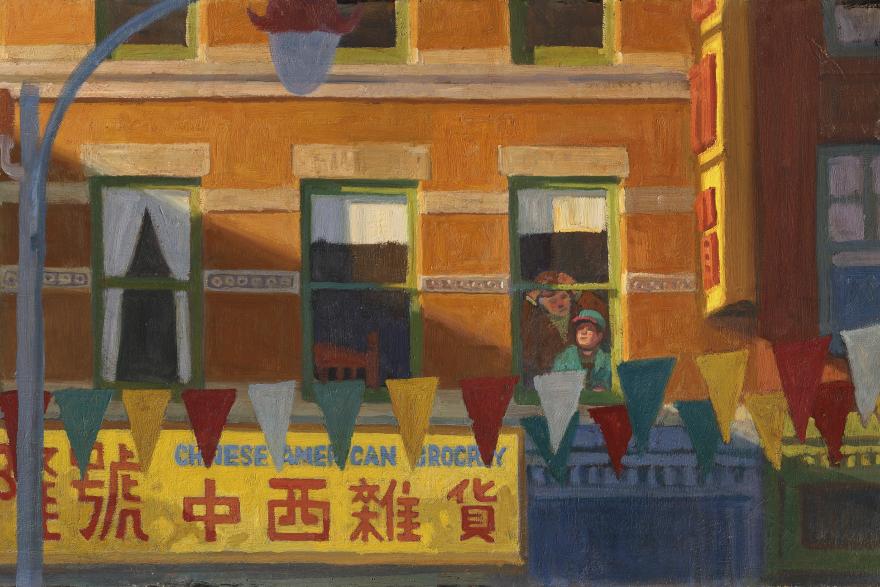
At Home in New York
Artists and other observers have long been fascinated by the challenges and opportunities of making a life in New York City. Using a wide range of media, they have told stories about home in New York that reflect on the best—and the worst—aspects of urban living.
In some cases, these are stories of a New York tinged with a spirit of fantasy and adventure, grandeur and the unexpected. Other observers show home in New York as fraught with annoyances tied to cramped quarters and ever-present neighbors. Movies, literature, classic sitcoms, and children’s books never tire of stories of New Yorkers eavesdropping through the walls, peering into windows, encountering a cast of characters in quirky homes, or merely venturing out on a stoop, where home life blends with neighborhood life.
Pick up a book or DVD from the shelf and place it at the end table to unlock an iconic New York story.
Right
[My Neighbors, Flower District, Chelsea, New York, from the series “Out My Window”]
Gail Albert Halaban, 2021
Archival pigment print
Courtesy of Gail Albert Halaban
Gail Albert Halaban moved to New York from Los Angeles in 2004. In her words, “I braced myself for feelings of isolation in a congested city. Awakened by my hungry baby, I would spend nights staring out my window. At two in the morning the club crowd reveled below; in the predawn the flower shops would open to begin the day with bouquets of color. At times, in those most intimate of moments with my daughter, I caught people returning my gaze.”
While Halaban’s work, with its array of ever-present apartment windows and the stories they contain, reflects a sense of voyeurism, she in fact collaborated with residents both to access and stage the scenes that she captured. Through these domestic vignettes Halaban evokes the tensions between density and privacy, and interior living and the exposure to the larger city that are inherent qualities of living in New York.
LIVING WITH NEIGHBORS
In a city where people live literally on top of each other, and neighbors can be seen and heard through windows and airshafts, the density of life in New York has been both provocative and inspiring. Noises above and below, encounters in common spaces like elevators and laundry rooms, and acts of listening in—or outright voyeurism—are all familiar tropes of New York apartment living.
Whether living in high-rise apartment buildings or on narrow brownstone blocks, New Yorkers at home are never quite alone. In stories about a city where space is at a premium, urban density can have challenging, hilarious, and even terrifying implications.
Left Column; Top to Bottom
[Rear Window Spanish-language lobby card]
Directed by Alfred Hitchcock, 1954
Ink on paper
Private collection
[Rear Window production still]
Directed by Alfred Hitchcock, 1954
Reproduction
Courtesy of Universal Studios Licensing LLC
Alfred Hitchcock’s urban thriller focuses on a photographer laid up with a broken leg who sniffs out a murder while finding entertainment in his courtyard during a heat wave. Based on a real courtyard on Christopher Street in Greenwich Village, the set for Rear Window was constructed entirely at Paramount Studios in Hollywood, and its scale and complexity set new industry standards.
[Murad ad]
P. Lorillard Co., 1929
Reproduction
Museum of the City of New York. Gift of Hardinge Scholle, 30.14.299
[Living Single production still]
Created by Yvette Lee Bowser, 1993
Reproduction
Licensed by Warner Bros. Entertainment Inc.
Airing from 1993 to 1998, Living Single focused on the lives of a group of Black friends sharing a brownstone in Prospect Heights, Brooklyn. It also launched the acting career of rapper Queen Latifah—and initiated a new generation of comedies focused on the intertwined lives of urban singles, including Friends and Sex and the City.
[Artwork from The Brownstone]
Stan Mack, c. 1972
Ink on paper
University of Minnesota Libraries. Stan Mack papers, Kerlan Collection, Children’s Literature Research Collections
Audio Tour: 300
In 1973 graphic designer Paula Scher collaborated with cartoonist Stan Mack to create a tale of a New York brownstone filled with bickering neighbors. A microcosm of the challenges of living in small spaces—the bears just want to hibernate, but the kangaroos will not stop tap dancing—The Brownstone also reflects the creativity that emerges from apartment living.
Middle Column; Top to Bottom
City Living
Harry Bliss, 2018
Ink on paper
Private collection
Audio Tour: 301
“Life in a New York City Apartment”
Alan Dunn, 1948
Paper and ink
Private collection
[The Honeymooners script with cigarette burns]
Jackie Gleason, 1955
Reproduction
Courtesy of CBS Broadcasting Inc. and Harry Ransom Center, The University of Texas at Austin
Set in Bensonhurst, Brooklyn, The Honeymooners focused on the bickering between and among a pair of couples who exemplified blue-collar apartment dwellers in the mid-20th century. The show became an icon for its depiction of the wise-cracking, sometimes raucous nature of married life inside a New York apartment building.
Living Single Aroma-Vision Card
Fox Broadcasting Company, 1994
Ink on paper
Private collection
[Artwork from The Brownstone]
Stan Mack, c. 1972
Ink on paper
University of Minnesota Libraries. Stan Mack papers, Kerlan Collection, Children’s Literature Research Collections
Right Column; Top to Bottom
[Awake and Sing! flyer]
Playwright Clifford Odets, 1935
Reproduction
Museum of the City of New York. Collection on Broadway Productions, F2011.41.53
Set during the Great Depression, Clifford Odets’s stage drama Awake and Sing! looks inside the struggles and frustrations of a Jewish family within the cramped confines of their Bronx apartment. The claustrophobic home heightens the social and economic pressures experienced by the cast.
[“Life in a New York City Apartment” detail]
Alan Dunn, 1948
Reproduction
Private collection
[The Honeymooners production still]
Created by Jackie Gleason, 1955–1956
Reproduction
Courtesy of CBS Broadcasting Inc. and Everett Collection
[Original drawings from Keeping the City Going]
Brian Floca, 2021
Ink and watercolor on paper
Collection of Brian Floca
Audio Tour: 302
In 2021 Brooklyn-based illustrator Brian Floca reflected on the COVID-19 lockdowns from a child’s perspective. Keeping the City Going celebrates the ways in which New Yorkers took advantage of their dense neighborhoods to find support and community at a time when isolation was a requirement and a challenge for all.
HOME AS AN ICON
In a city populated with ornate buildings, classic brownstones, and structures that are true icons, many New York dwellings often represent more than just a home and can be playgrounds of excitement and inspiration. Indeed, the city’s housing contains a cast of characters that generate adventure and some unique challenges, and opportunities, for their inhabitants.
Left Column; Top to Bottom, Left to Right
[East 88th Street sign]
Unknown maker, Undated
Metal and vinyl
Courtesy of the Bernard Waber Literary Trust
Rosemary’s Baby
Ira Levin, 1967
Ink on paper
Private collection
In Ira Levin’s 1967 novel, a young couple moves into a notorious, fictional apartment house known as the Bramford, and the whispers of the building’s sinister past soon become reality for the expectant parents. When Roman Polanski adapted the book for the screen in 1968, the Dakota on West 72nd Street played the role of the Bramford.
[Rosemary’s Baby production still]
Directed by Roman Polanski, 1968
Reproduction
Courtesy of Paramount Pictures and Getty Images
Watching the Wheels
John Lennon, 1980
Ink on cardboard
Private collection
While known as an elegant and frequently photographed apartment house, the Dakota took on another identity when John Lennon and Yoko Ono became its most famous residents in 1973. The building gained a new level of urban notoriety when Lennon was murdered outside the building seven years later.
[The Jeffersons production still]
Created by Norman Lear, 1975–1985
Reproduction
Courtesy of Sony Pictures Television
TV Guide
TV Guide Publishing Group, Inc., 1983
Ink on paper
Private collection
Audio Tour: 310
A spin-off from All in the Family, The Jeffersons broke new ground with the story of a prosperous Black family who relocates from Queens to a “deluxe apartment in the sky.” Their new home is the Colby East, a fictional apartment building on the Upper East Side of Manhattan.
Suzuki Beane
Sandra Scoppettone, 1961
Ink on paper
Private collection
In response to the privileged world of the Eloise series, Sandra Scoppettone and Louise Fitzhugh collaborated on a satirical story about a girl living in Greenwich Village with her beatnik parents.
[Eloise children’s menu]
Hilary Knight, Undated
Ink on paper
Museum of the City of New York. Gift of the Plaza Hotel, 97.29.5
[Eloise’s ice cream sundae]
Henry Luhrman, 1996
Plastic
Museum of the City of New York. Gift of Mr. Hilary Knight, 98.12.1B
Originally titled Eloise: A Book for Precocious Adults, Kay Thompson’s book centers around a girl’s adventures living at the Plaza Hotel. Thompson was Liza Minnelli’s godmother, and some have speculated that Minnelli inspired Eloise.
Right Column; Top to Bottom, Left to Right
[Original drawings from The House on East 88th Street]
Bernard Waber, 1962
Ink on paper
Courtesy of the Bernard Waber Literary Trust
When the Primm family moves into their new home on East 88th Street, they are astonished to find a large, yet loving, crocodile living in the bathtub. In time the family settles in to adore their home in part because of the crocodile that it introduces into their lives.
[Original drawing from The Saturdays]
Elizabeth Enright, 1941
Ink on paper
University of Minnesota Libraries. Elizabeth Enright papers, Kerlan Collection, Children’s Literature Research Collections
[First edition of The Saturdays]
Elizabeth Enright, 1941
Ink on paper
Private collection
The four Melendy children, their widowed father, and their loving but strict housekeeper live in a midtown brownstone. While the children yearn to have adventures around the city, they always return to the home that seems to embrace them like another member of the family.
[Facsimile of Plaza Hotel bill for room service charges]
Hilary Knight, Undated
Ink on paper
Museum of the City of New York. Gift of Gift of Mr. Hilary Knight, 98.12.1G
[Illustrated notecards from From Mixed-Up Files of Mrs. Basil E. Frankweiler]
Elaine Lobl Konigsburg, 1973
Ink on paper
Archives & Special Collections, University of Pittsburgh Library System
From the Mixed-Up Files of Mrs. Basil E. Frankweiler
Elaine Lobl Konigsburg, 1967
Ink on paper
Private collection
Audio Tour: 311
Sometimes a home may not be a home at all but a dramatic landmark. In this urban adventure story, Claudia and her brother run away to the Metropolitan Museum of Art. While the plot features a mysterious sculpture, much of the action centers on the clandestine routine of kids bunking down at a world-class art museum.
INSIDE AND OUTSIDE
The fluid relationship between indoors and outdoors is a recurring theme in depictions of a city noted for small apartments and densely packed neighborhoods. Especially in the days before air conditioning and television, the dark, crowded, and noisy nature of apartments and tenements frequently prompted home life to move outside.
New Yorkers, and kids in particular, watched, played, gossiped, or just cooled off in spaces that blended public and private realms. Artists in all genres have long been fascinated by the spectacle of life spilling onto the sidewalk in the warm weather and by the lure and entertainment of watching the streets outside.
Left Column; Top to Bottom
[Original drawing of April from In the Year of the Boar and Jackie Robinson]
Marc Simont, 1984
Reproduction
Marc Simont Papers, Archives & Special Collections, University of Connecticut Library
In Bette Bao Lord’s autobiographical novel about arriving in Brooklyn from Shanghai in the years after World War II, fifth-grader Shirley Temple Wong finds a connection between the stoopball played by her neighbors and the games that she played in China, as she struggles with a language barrier and her own feelings of isolation.
Wah Mee Hand Laundry
William Low, 2007, printed 2023
Digital print
Collection of William Low
Audio Tour: 320
Bronx-born artist William Low grew up in an apartment above his parents’ hand laundry. He depicted his childhood time being spent in the family’s business, remembering that the apartment was only for sleeping—a common experience for the children of immigrant entrepreneurs.
[The Goldbergs production still]
John Vachon for LOOK magazine, 1949
Reproduction
Museum of the City of New York. The LOOK Collection. Gift of Cowles Magazines, Inc., X2011.4.11805
From 1949 to 1956 television audiences were riveted by Molly Goldberg, a middle-aged Jewish woman in the Bronx, who regularly called “Yoo-Hoo!” from her window. In New York, windows can be a portal from a cramped apartment home into the streets, where the real action is happening.
Chinatown Apartment Painting
William Low, 1997
Oil on board
Collection of William Low
[Illustration for pages 18–19 of Peter’s Chair]
Ezra Jack Keats, 1967
Collage of cut paper, wax crayon, and acrylic and gouche-painted cardstock
Ezra Jack Keats Papers (DG0001), de Grummond Children’s Literature Collection, Special Collections in McCain Library and Archives, The University of Southern Mississippi, box 50, folder 10
Brooklyn-born Ezra Jack Keats is perhaps best known for his 1962 book The Snowy Day. In Peter’s Chair, readers are reintroduced to the character of Peter through his frustration at the arrival of his baby sister—which he expresses by “running away” to the sidewalk outside his apartment.
Right Column; Top to Bottom
When the Heat Holds On
Rollin Kirby, 1931
Graphite on illustration board
Museum of the City of New York. Gift of Mr. Rollin Kirby, 43.366.177
Although Rollin Kirby was known mostly as a political cartoonist, here he highlights life in tightly packed tenement neighborhoods. For many residents, the stoop or the sidewalk could be the only respite from broiling heat.
Harlem Window, NYC, 1940s
Erika Stone, c. 1945, printed c. 1960
Gelatin silver print
Museum of the City of New York. Gift of Erika Stone, 2012.3.17
[Original drawing from Gina]
Bernard Waber, 1995
Ink on paper
Collection of the Bernard Waber Estate
Audio Tour: 321
In Bernard Waber’s story, Gina feels like an outsider in her new Queens neighborhood. She meets kids who find joy and entertainment inside their building—and while cheering on the pickup basketball games at their apartment complex.
West of the Circle
Don Freeman for Newstand, 1941
Reproduction
Courtesy of the estate of Don Freeman
East of the Circle
Don Freeman for Newstand, 1941
Ink on paper
Museum of the City of New York. Gift of Michael Karp, 2013.13.43.8
Best known for his children’s books like Corduroy, Don Freeman captured the bustle of New York City in his early work. In these two works, he contrasts the ways different social classes spill out from their homes in New York.
MANAGING SPACE
The challenges—and creative opportunities—that come with living in New York City have been a subject of recurring fascination for artists and chroniclers of the city. Both the flamboyant dwellings and tight quarters that characterize many of the city’s living spaces have been documented across a range of media.
In a city where housing comes at a high cost, many New Yorkers also face daily battles to feel the comfort, security, and joy of home—a struggle that can inspire both awe and compassion in artistic representation.
Left Column; Top to Bottom
Emma in Her Room, Shelter-in-Place Time, Corona Days
Elinor Carucci, 2020
Pigment print
Elinor Carucci courtesy Edwynn Houk Gallery
Audio Tour: 330
During the COVID-19 pandemic, Elinor Carucci documented her family’s life in the confines of their apartment. The mother of teenage twins, Carucci has been particularly fascinated by the worlds that teenagers create for themselves in their bedrooms—highlighting both the personal expression and the claustrophobia that the bedrooms reflect.
[At Home in Harlem, New York With James Reynolds and Son Jerome Williams, from the series “Father Figure: Exploring Alternate Notions of Black Fatherhood”]
Zun Lee, 2011
Archival pigment print
Collection of KSMoCA (Dr. Martin Luther King Jr. School Museum of Contemporary Art)
Zun Lee’s photographs explore themes of Black family life and especially fatherhood. In this portrait of Jerome Williams (left) in the Harlem apartment of his art teacher and mentor, James Reynolds (right), the portrait of educator Booker T. Washington and the framing of the two men in this domestic context underscore the strength and depth of their social bond.
[Snug and Safe from Gowanus Dogs]
Jonathan Frost, 1999
Etching
Collection of the artist
For many New Yorkers, home is an elusive goal. When illustrator Jonathan Frost was in art school, he lived near Brooklyn’s Gowanus Canal. For this book he drew inspiration from the unhoused people and dogs who sought warmth and comfort in that former industrial site.
Right Column; Top to Bottom
Liz Duffy Adams
Sally Davies, 2019
Pigment print
Museum of the City of New York. Museum purchase, 2022.16.16
A street photographer for 30 years, Sally Davies shifted her focus indoors in 2019 to document domestic spaces. Intrigued by the creative intensity that many New Yorkers pour into their dwellings, Davies tells a story about the city and its people though a look at the often-tiny homes that New Yorkers curate for maximum impact.
Bath Time
Thomas Holton, 2004
Pigment print
Museum of the City of New York. Museum purchase, 2017.34.1
In 2003 Thomas Holton embarked on a multi-year project to document the life of a Chinese immigrant family in their 350-square-foot apartment. “The Lams of Ludlow Street” series explores the ways in which the physical challenges and opportunities of living in a confined space can mirror the experience of assimilation and belonging.
[Illustrations of Tyreek in his peaceful space from Summer Housing Boy]
Shaniqua Horton, illustrated by Ninakupenda Gaillard, 2019, printed 2023
Reproduction
Courtesy of author Shaniqua Horton, www.housingboy.com
Audio Tour: 331
Shaniqua Horton, who grew up in a New York City Housing Authority complex near Mariners Harbor, Staten Island, drew on her childhood experiences for her story of a boy who lives in city housing. Tyreek, who dreams of being an architect, takes readers on a tour of his community and shares his ambitions for the future.
[Original drawings from Little Elliot]
Mike Curato, 2014 |
Pencil on paper
Courtesy of the artist
Audio Tour: 332
The typical challenge faced by New Yorkers is one of space–and having too little of it. By contrast Little Elliot, a tiny spotted elephant who lives alone, has found ways to adapt and survive in a home and a city that is too large for him.
